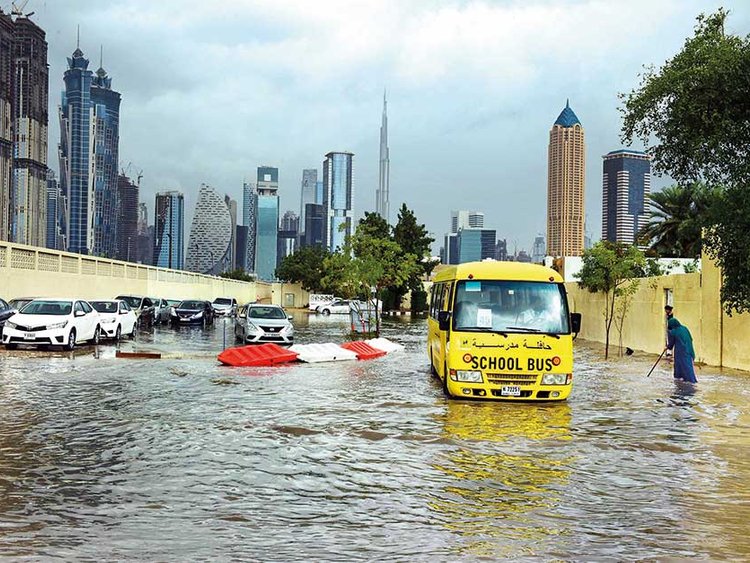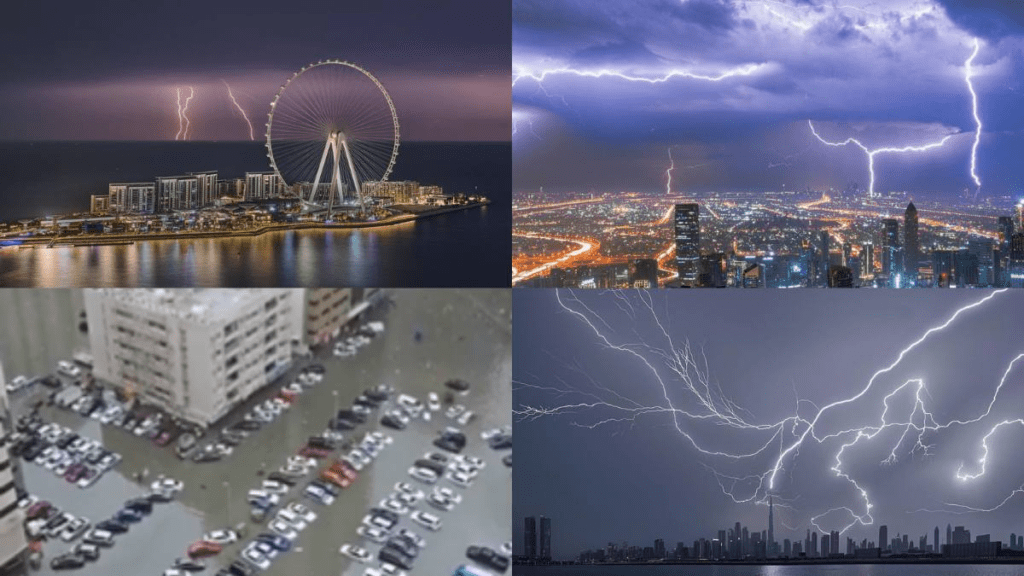The United Arab Emirates (UAE) has been hit by one of the worst storms in its history, causing widespread chaos across the country. Heavy rains, strong winds, and thunderstorms have flooded major cities, disrupted daily life, and forced authorities to take emergency measures. The storm has impacted transportation, schools, businesses, and daily activities, leaving many residents struggling to cope with the unexpected weather disaster. The extreme weather event has also raised concerns about climate change and the need for improved infrastructure to handle such situations in the future.
Unprecedented Rainfall Causes Severe Flooding
Meteorologists have described this storm as one of the most intense in decades. Heavy rainfall, which continued for several hours, led to severe flooding in cities like Dubai, Abu Dhabi, and Sharjah. Streets turned into rivers, with water levels rising so high that vehicles were submerged. In many areas, people were stranded, unable to leave their homes or workplaces due to the dangerous floodwaters.
Authorities have deployed emergency response teams to rescue people from flooded areas and assist in clearing water from the streets. Videos circulating on social media show cars floating on roads, shopping malls with water pouring in, and residents wading through knee-deep floods. In some areas, people had to be rescued using inflatable boats, as roads became completely impassable.

The storm also damaged several properties, including homes, offices, and commercial buildings. Many residents reported water leaking from ceilings, while others experienced power cuts due to electrical faults caused by water damage. Emergency maintenance teams were deployed to fix power lines and restore electricity to affected areas as quickly as possible.
Flights Canceled, Schools Closed, and Businesses Affected

The extreme weather has significantly disrupted travel across the country. Several flights from Dubai and Abu Dhabi airports were delayed or canceled due to poor visibility and waterlogged runways. Airlines advised passengers to check flight schedules before heading to the airport. The heavy rainfall also caused major traffic jams, with some highways temporarily shut down to prevent accidents.
As a safety precaution, schools across the UAE were ordered to remain closed, with students attending online classes instead. Many businesses allowed employees to work from home to ensure their safety. Public transport, including metro services and buses, experienced significant delays due to flooded roads and station closures. Ride-hailing services and taxis were also affected, with many drivers unable to navigate through flooded streets, leading to increased demand and higher fares.
Retail stores and restaurants in some areas had to shut down due to flooding and power outages. Malls, which are usually busy hubs of activity, saw lower foot traffic as people avoided going out during the storm. Some businesses took proactive steps by reinforcing barriers and using sandbags to prevent floodwaters from entering their premises, but not all were successful in preventing damage.
Government and Authorities Take Swift Action
The UAE government and emergency services have been working tirelessly to manage the crisis. Authorities issued weather warnings in advance, urging residents to stay indoors and avoid unnecessary travel. Police and civil defense teams were dispatched to assist those affected, and drainage systems were put under high pressure to clear the water as quickly as possible.

The National Center of Meteorology (NCM) reported that the unusual amount of rainfall was partly due to a rare weather system affecting the region. They also assured the public that efforts were underway to control the situation and prevent further damage. Officials have stated that additional measures may be taken in the coming days to address the long-term effects of the storm.
In addition to local government efforts, international weather monitoring agencies have expressed interest in studying this extreme weather event, as the UAE is typically known for its arid climate. Climate experts believe that such events could become more frequent due to global warming and shifting weather patterns, emphasizing the importance of improved disaster preparedness.
How Residents Are Coping With the Storm
For many UAE residents, this level of extreme weather is rare and unexpected. Many people took to social media to share their experiences, posting videos and pictures of flooded streets, leaking ceilings, and abandoned cars. Some residents have had to deal with power outages and water supply disruptions, adding to the difficulties.
Local supermarkets and convenience stores reported an increase in demand for essential items, as people stocked up on food, water, and emergency supplies. Meanwhile, volunteers and community groups have come together to offer help to those in need, providing shelter and transportation to stranded individuals.
Many residents have called for better drainage systems and improved urban planning to prevent such flooding in the future. Experts have suggested that cities like Dubai and Abu Dhabi should invest more in stormwater management systems, as climate change could lead to more unpredictable weather patterns. Some have also raised concerns about insurance claims, as many vehicle owners and homeowners will now have to deal with the financial burden of repairing damages caused by the storm.
What Happens Next?
Weather experts predict that the storm will gradually weaken over the next few days, but residual flooding and water damage will take time to clear. Authorities are urging residents to remain cautious and avoid flood-affected areas until the situation improves. Cleanup crews are working around the clock to pump out excess water and clear debris from roads to restore normal traffic flow.
The UAE government is expected to review the storm’s impact and consider further measures to enhance infrastructure to withstand extreme weather in the future. Experts have suggested that better flood control measures, such as improved drainage systems and water diversion strategies, should be implemented to prevent similar disasters from occurring again.
Residents are encouraged to report any flood-related damages to local authorities for assistance and to follow safety guidelines issued by emergency services. In the meantime, businesses and homeowners are left to deal with the aftermath, assessing the cost of damages and beginning the long process of recovery.
Conclusion
The recent storm in the UAE has been one of the most severe in history, affecting transportation, businesses, and daily life. While emergency services have responded quickly, the aftermath of the floods remains a challenge. As the country moves forward, lessons learned from this event may lead to better preparedness for future extreme weather conditions. For now, residents are advised to stay safe and follow official updates as recovery efforts continue. The storm serves as a reminder of the power of nature and the importance of investing in resilient infrastructure to protect cities from unexpected climate events.
Also read: New Dubai-to-Oman Route Opens: Everything You Need to Know!













